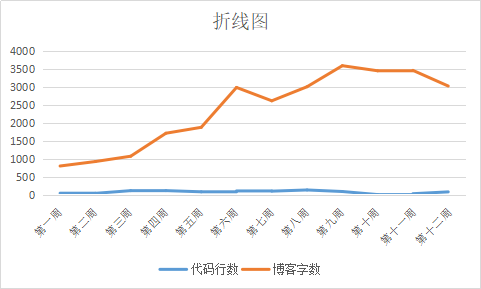第十二周作业
| 这个作业属于哪个课程 | C语言程序设计ll |
| 这个作业要求在哪里 | https://edu.cnblogs.com/campus/zswxy/software-engineering-class1-2018/homework/3235 |
| 我在这个课程的目标是 | 了解并学习指针进阶,主要内容是指针数组和二级指针 |
| 这个作业在哪个具体方面帮助我实现目标 | 这个作业让我了解和学习指针数组和二级指针的知识,更深入了解指针 |
| 参考文献 | 书本第十一章的知识以及百度查阅的知识 |
一、基础题
6-1 计算最长的字符串长度 (15 分)
本题要求实现一个函数,用于计算有n个元素的指针数组s中最长的字符串的长度。
函数接口定义:
int max_len( char *s[], int n );
其中n个字符串存储在s[]中,函数max_len应返回其中最长字符串的长度。
裁判测试程序样例:
#include <stdio.h>
#include <string.h>
#include <stdlib.h>
#define MAXN 10
#define MAXS 20
int max_len( char *s[], int n );
int main()
{
int i, n;
char *string[MAXN] = {NULL};
scanf("%d", &n);
for(i = 0; i < n; i++) {
string[i] = (char *)malloc(sizeof(char)*MAXS);
scanf("%s", string[i]);
}
printf("%d\n", max_len(string, n));
return 0;
}
/* 你的代码将被嵌在这里 */
输入样例:
4
blue
yellow
red
green
输出样例:
6
1.实验代码
int max_len( char *s[], int n )
{
int i,l = 0,len = 0;
for(i = 0;i < n;i++)
{
l = strlen(s[i]);
if(len < l)
{
len = l;
}
}
return len;
}
全部代码
#include <stdio.h>
#include <string.h>
#include <stdlib.h>
#define MAXN 10
#define MAXS 20
int max_len( char *s[], int n );
int main()
{
int i, n;
char *string[MAXN] = {NULL};
scanf("%d", &n);
for(i = 0; i < n; i++) {
string[i] = (char *)malloc(sizeof(char)*MAXS);
scanf("%s", string[i]);
}
printf("%d\n", max_len(string, n));
return 0;
}
int max_len( char *s[], int n )
{
int i,l = 0,len = 0;
for(i = 0;i < n;i++)
{
l = strlen(s[i]);
if(len < l)
{
len = l;
}
}
return len;
}
2.设计思路
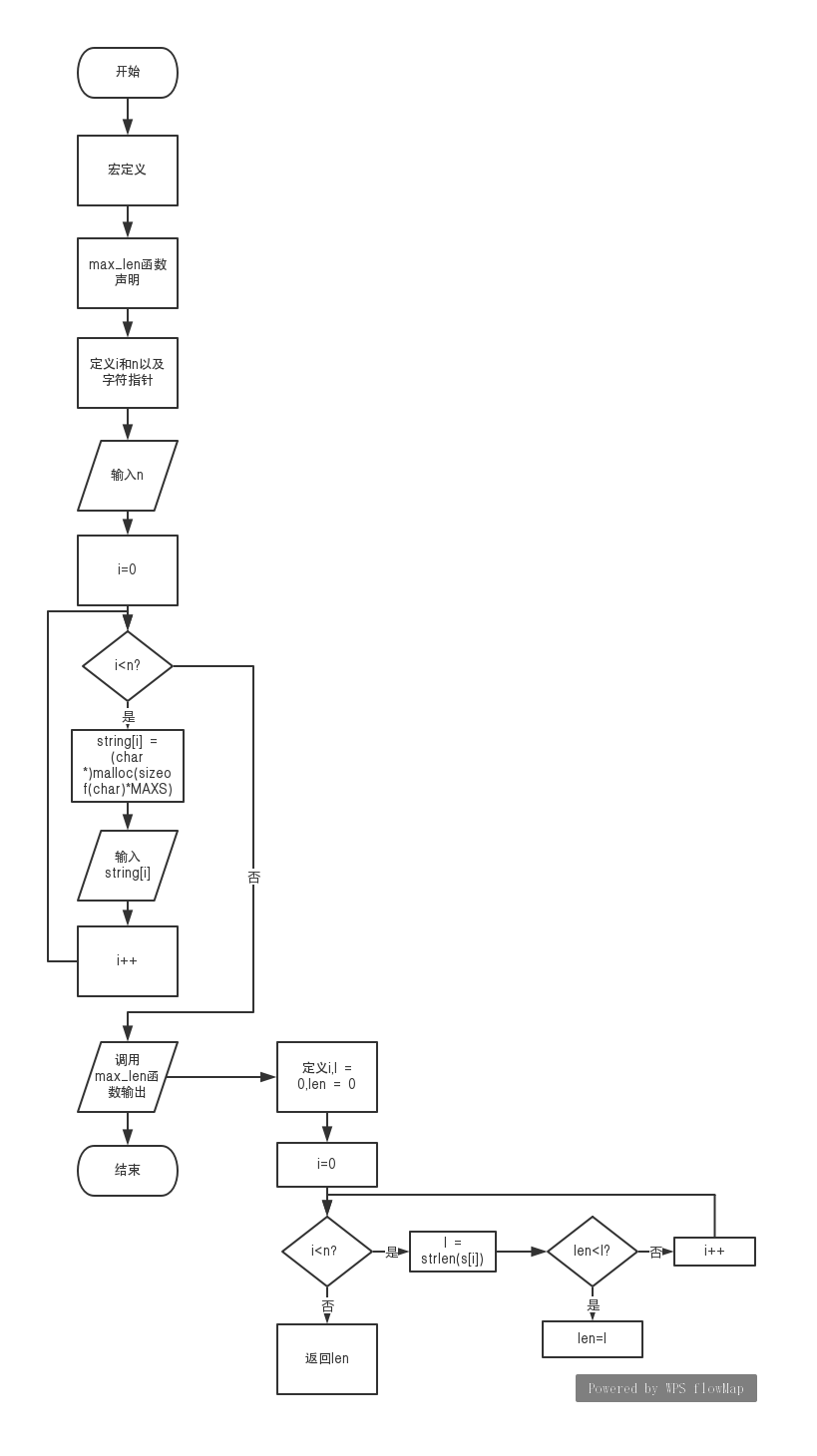
3.解题过程中遇到的问题及解决办法
问题:把所有的代码直接打上去,一直没发现错误;第一次赋值的时候弄错了
解决方法:检查了之后才改过来了,编译正确。
4.运行结果截图
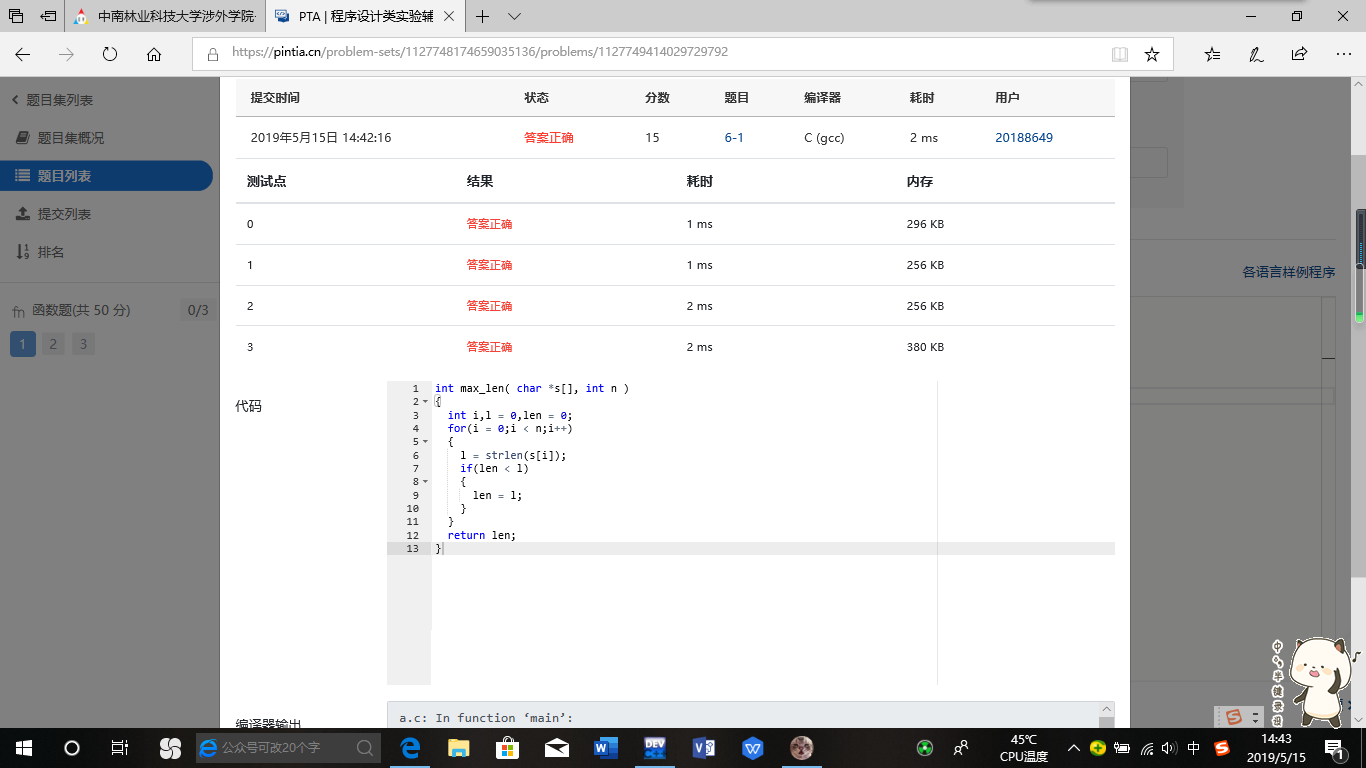
6-2 统计专业人数 (15 分)
本题要求实现一个函数,统计学生学号链表中专业为计算机的学生人数。链表结点定义如下:
struct ListNode {
char code[8];
struct ListNode *next;
};
这里学生的学号共7位数字,其中第2、3位是专业编号。计算机专业的编号为02。
函数接口定义:
int countcs( struct ListNode *head );
其中head是用户传入的学生学号链表的头指针;函数countcs统计并返回head链表中专业为计算机的学生人数。
裁判测试程序样例:
#include <stdio.h>
#include <stdlib.h>
#include <string.h>
struct ListNode {
char code[8];
struct ListNode *next;
};
struct ListNode *createlist(); /*裁判实现,细节不表*/
int countcs( struct ListNode *head );
int main()
{
struct ListNode *head;
head = createlist();
printf("%d\n", countcs(head));
return 0;
}
/* 你的代码将被嵌在这里 */
输入样例:
1021202
2022310
8102134
1030912
3110203
4021205
#
输出样例:
3
1.实验代码
int countcs( struct ListNode *head )
{
int n=0;
while (head!=0)
{
if(head->code[1]=='0'&&head->code[2]=='2')
{
n++;
}
head=head->next;
}
return n;
}
全部代码
#include <stdio.h>
#include <stdlib.h>
#include <string.h>
struct ListNode {
char code[8];
struct ListNode *next;
};
struct ListNode *createlist();
int countcs( struct ListNode *head );
int main()
{
struct ListNode *head;
head = createlist();
printf("%d\n", countcs(head));
return 0;
}
int countcs( struct ListNode *head )
{
int n=0;
while (head!=0)
{
if(head->code[1]=='0'&&head->code[2]=='2')
{
n++;
}
head=head->next;
}
return n;
}
2.设计思路
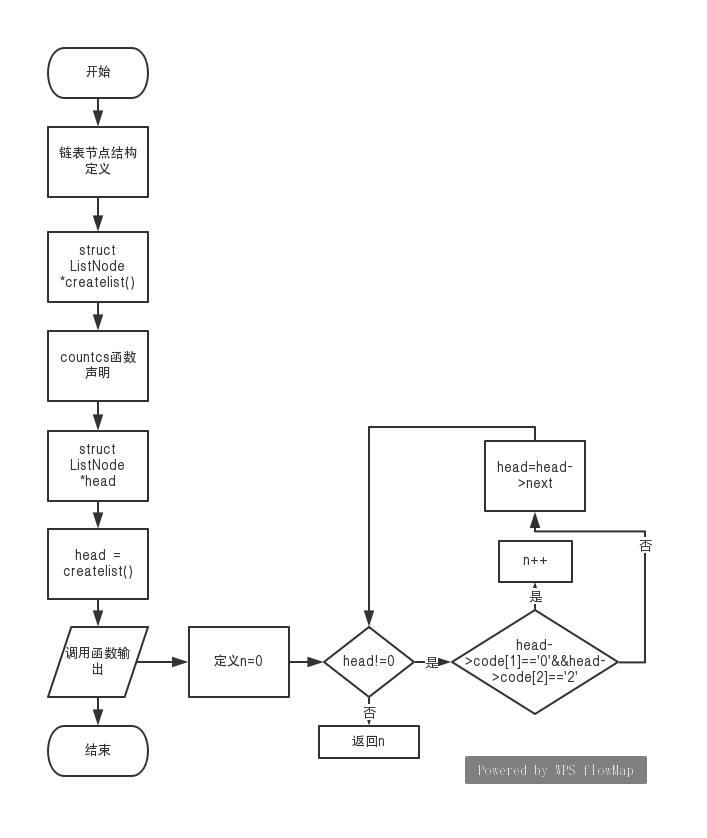
3.解题过程中遇到的问题及解决办法
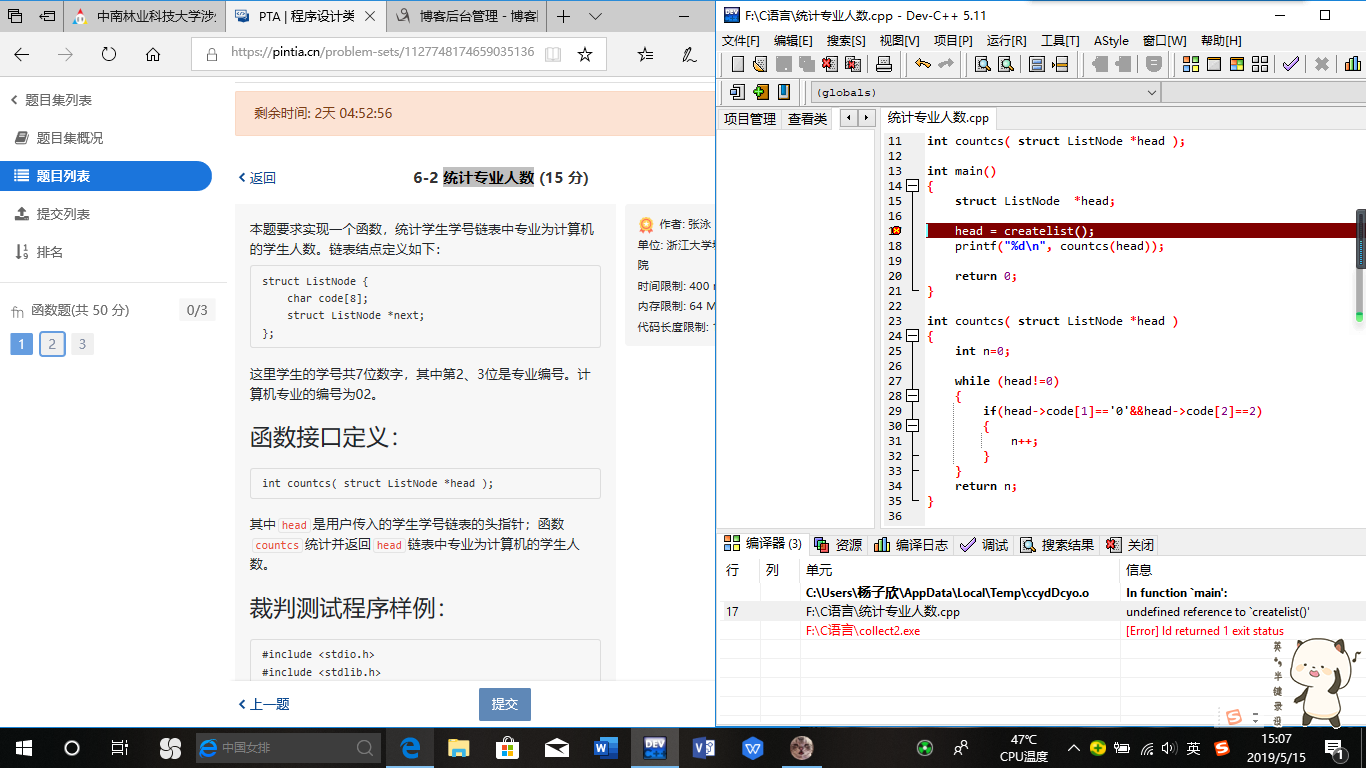
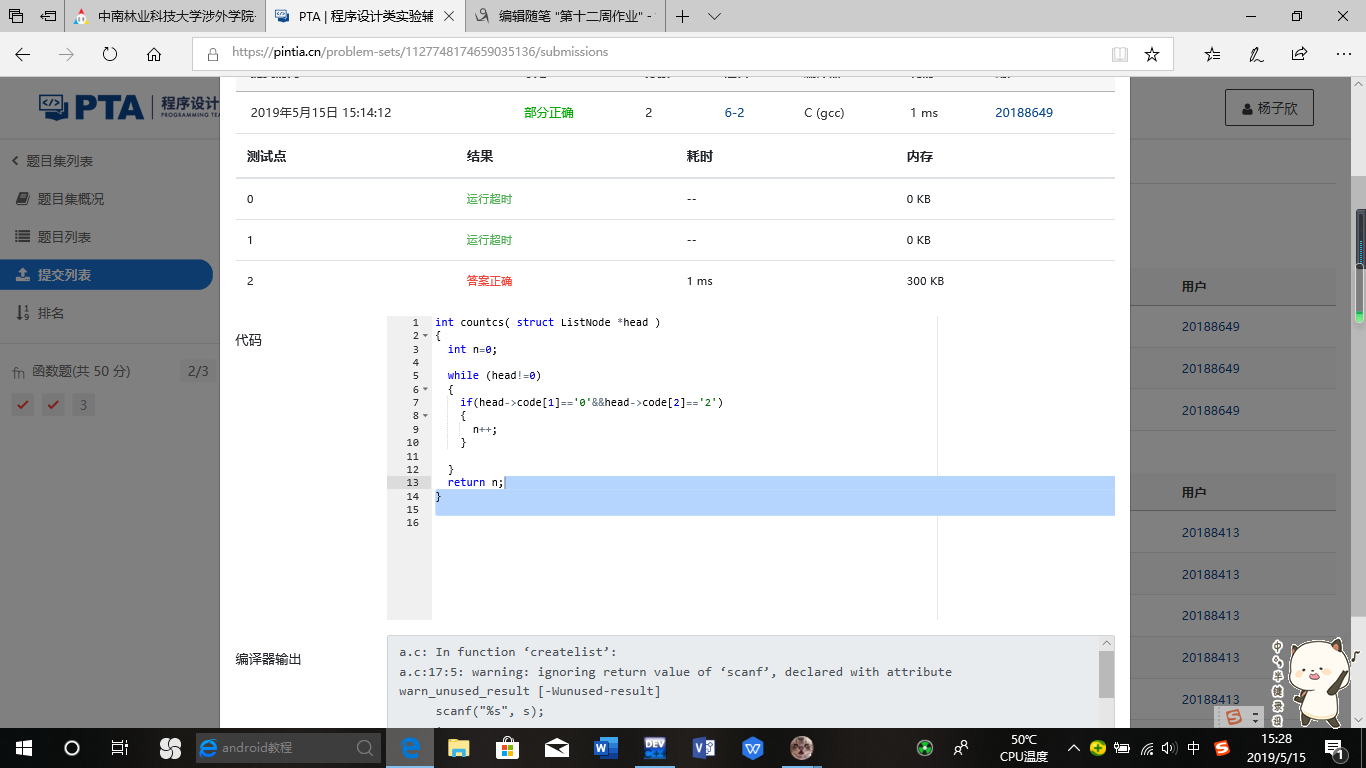
问题:在while语句中忘记给head的值变换,导致有部分答案错误。
解决方法:在末尾加上变换head的值的语句,正确。
在dev-c++上编译不出来,有个地方会报错,好像是代码本身的问题,我也不知道怎么回事。
4.运行结果截图
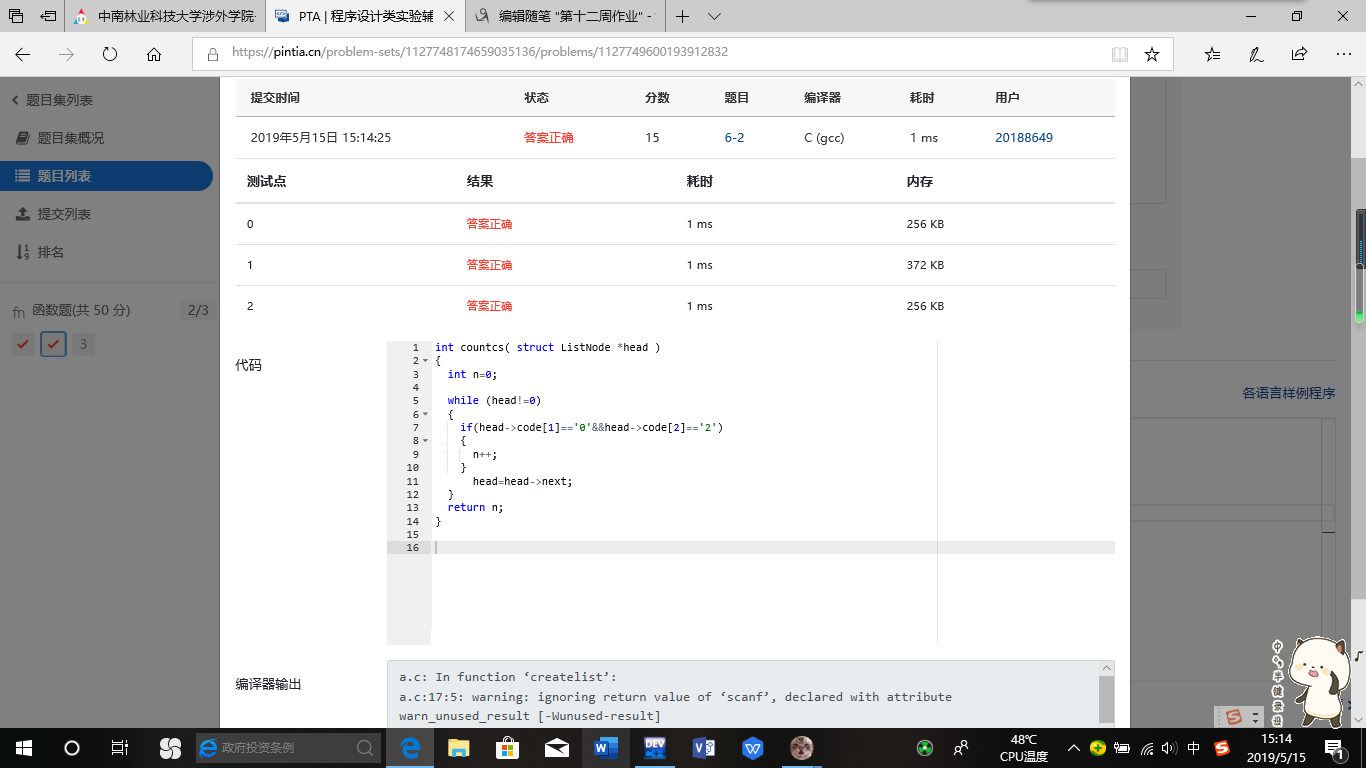
6-3 删除单链表偶数节点 (20 分)
本题要求实现两个函数,分别将读入的数据存储为单链表、将链表中偶数值的结点删除。链表结点定义如下:
struct ListNode {
int data;
struct ListNode *next;
};
函数接口定义:
struct ListNode *createlist();
struct ListNode *deleteeven( struct ListNode *head );
函数createlist从标准输入读入一系列正整数,按照读入顺序建立单链表。当读到−1时表示输入结束,函数应返回指向单链表头结点的指针。
函数deleteeven将单链表head中偶数值的结点删除,返回结果链表的头指针。
裁判测试程序样例:
#include <stdio.h>
#include <stdlib.h>
struct ListNode {
int data;
struct ListNode *next;
};
struct ListNode *createlist();
struct ListNode *deleteeven( struct ListNode *head );
void printlist( struct ListNode *head )
{
struct ListNode *p = head;
while (p) {
printf("%d ", p->data);
p = p->next;
}
printf("\n");
}
int main()
{
struct ListNode *head;
head = createlist();
head = deleteeven(head);
printlist(head);
return 0;
}
/* 你的代码将被嵌在这里 */
输入样例:
1 2 2 3 4 5 6 7 -1
输出样例:
1 3 5 7
1.实验代码
struct ListNode *createlist()
{
struct ListNode *head,*p,*q;
int num;
head=(struct ListNode *)malloc(sizeof(struct ListNode));
p=q=(struct ListNode *)malloc(sizeof(struct ListNode));
p->next=q->next=head->next=NULL;
while(1)
{
scanf("%d",&num);
if(num!=-1)
{
p->data=num;
if(head->next!=NULL)
{
q->next=p;
q=p;
}
else
{
head->next=p;
}
p=(struct ListNode *)malloc(sizeof(struct ListNode));
p->next=NULL;
}
else
break;
}
return head;
}
struct ListNode *deleteeven(struct ListNode *head)
{
struct ListNode *num,*p1;
p1=head;
num=head->next;
while(num!=NULL)
{
if(num->data%2==0)
{
p1->next=num->next;
}
else
p1=p1->next;
num=num->next;
}
return head->next;
}
2.设计思路

3.解题过程中遇到的问题及解决办法
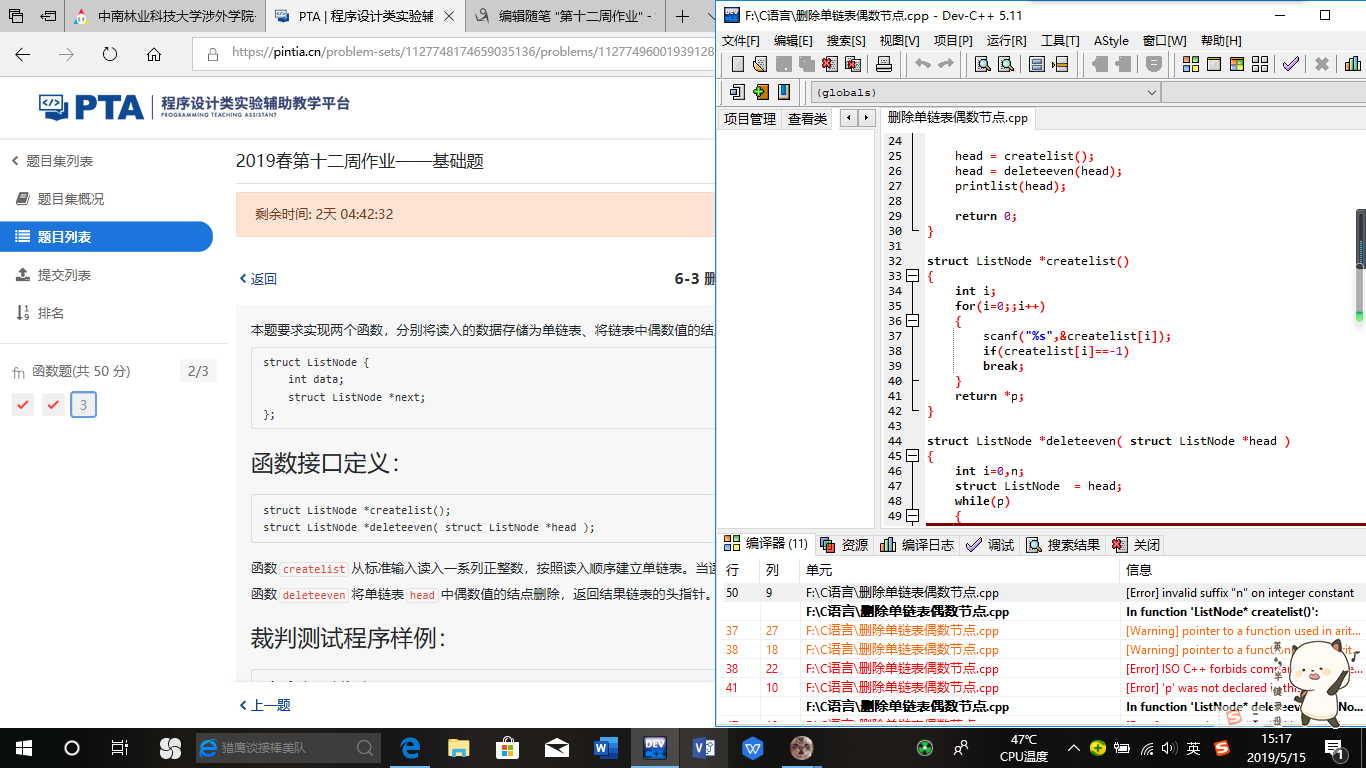
问题:这道题目我尝试了自己编写代码,结果错误很多,不会写
解决方法:在百度上搜了很多大佬的代码,然后还是不会,希望老师能讲解。
4.运行结果截图
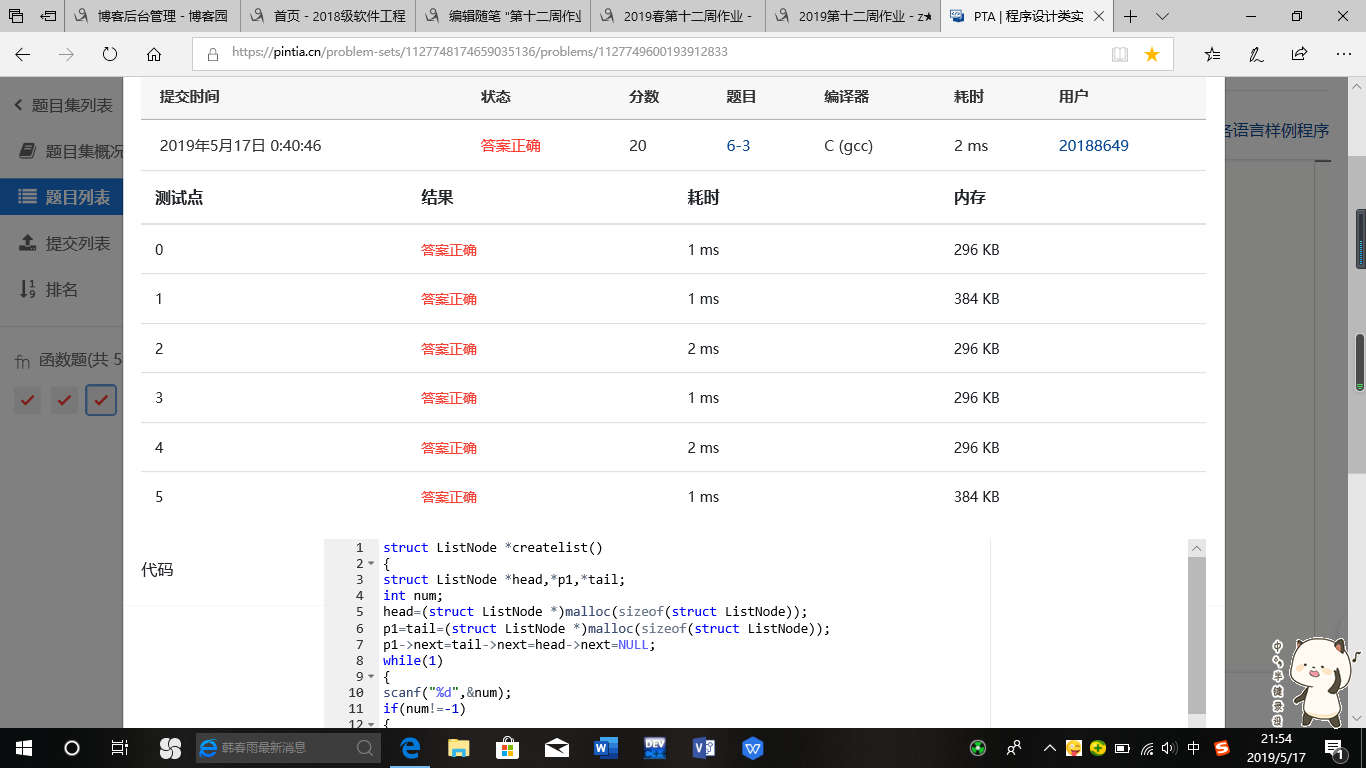
二、预习作业
1.所在小组想要开发的项目的名称和目标;
2.项目主体功能的描述;
3.现阶段已做的准备工作;
4.小组成员名单和进度安排。
小组成员名单:阳圣琪,邱治文,刘祺伟,杨子欣
我们组的想要开发的项目啥的还没太想好,还需讨论,等上完一节课再确定。
三、学习进度条
| 周/日期 | 这周所花的时间 | 代码行数 | 学到的知识点简介 | 目前比较迷惑的问题 |
|---|---|---|---|---|
| 2/25-3/3 | 2天 | 39 | 初次学习数组的用法 | 关于数组的一些具体的用法 |
| 3/4-3/10 | 2天 | 35 | 编写程序来处理文件数据 | 指针的具体用法和fscanf类型函数的理解 |
| 3/11-3/17 | 1天 | 59 | 第一题:编写程序处理文件数据 | 指针的具体用法 |
| 3/11-3/17 | 2天 | 51 | 第二题:用二维数组知识编写程序 | 二维数组的知识点不熟悉 |
| 3/18-3/24 | 2天 | 111 | 二维数组、选择法排序和冒泡法排序 | 选择法排序和冒泡法排序的区别 |
| 3/25-3/31 | 2天 | 78 | 判断回文,字符数组和使用字符串编程 | 使用字符串编程时的一些函数的用法 |
| 4/1-4/7 | 3天 | 102 | 指针的基本运算,数组和指针的结合 | 对于数组还是不熟悉 |
| 4/8-4/14 | 3天 | 96 | 冒泡排序,指针、数组和地址间的关系 | 指针和数组的关系和应用不太会,容易错 |
| 4/15-4/21 | 3天 | 129 | 常用的字符串处理函数和用指针实现内存动态分配 | 关于指针内存动态分配还不太熟悉 |
| 4/22-4/28 | 3天 | 86 | 了解和学习结构的概念与定义,结构变量的使用以及结构数组和指针的使用 | 结构指针不太会,可能是没用惯 |
| 4/29-5/5 | 1天 | ---- | 怎样花两年时间面试一个人;如何有效地记忆与学习;如何提问 | ---- |
| 5/6-5/12 | 2天 | 25 | 如何使用递归函数以及学习宏定义的知识 | 有挺多地方都不太懂,这次的作业很难,不会写 |
| 5/13-5/19 | 2天 | 指针进阶主要内容是指针数组和二级指针 | 感觉知识点很不熟悉,比较繁杂,有个作业不会写 |
四、学习感悟
这一周主要了解并学习了指针的深入了解,包括指针数组和数组指针,指向指针的指针也就是二级指针,一般定义为 类型名**变量名。行地址是二级指针,列地址是一级指针,还有一些二级指针的知识。然后就是指针函数,返回值为指针类型的函数叫做指针函数,还有函数指针的知识,我觉得这一周学了很多知识,同时也有很多易错的地方需要去记去熟悉。比如说:a+1就是行指针,而&a[1][0]、a[1]、*(a+1)和(int *)(a+1)都是列指针。在指针进阶中,我觉得尤为重要的是二级指针,这方面的知识要多熟悉,多看看;另外,这一周的作业第一题和第二题都挺好,第三题的话不会做,有一点思路,但写不出来。
五、结对编程感悟
这一周也没有进行结对编程,因为有事情一直在外面,作业都是周三之前和周五的时候做的,所以没有和搭档讨论题目,最后一题也不太会做,我觉得那个知识点比较难吧。所以也看了很多,搜了代码,想努力把它看懂。
六、表格、折线图
| 时间 | 代码行数 | 博客字数 |
|---|---|---|
| 第一周 | 39 | 798 |
| 第二周 | 35 | 923 |
| 第三周 | 110 | 1071 |
| 第四周 | 111 | 1713 |
| 第五周 | 78 | 1878 |
| 第六周 | 102 | 2991 |
| 第七周 | 96 | 2618 |
| 第八周 | 129 | 3011 |
| 第九周 | 86 | 3598 |
| 第十周 | ---- | 3456 |
| 第十一周 | 25 | 3468 |
| 第十二周 | 76 | 3031 |
